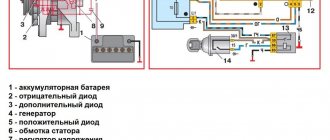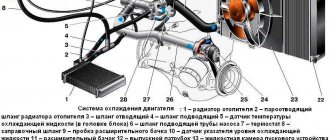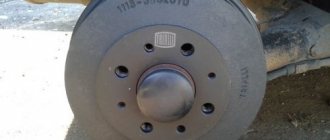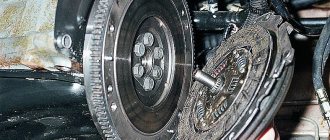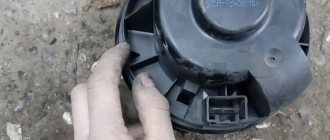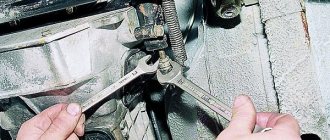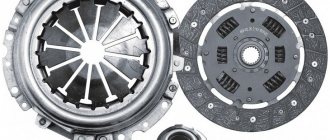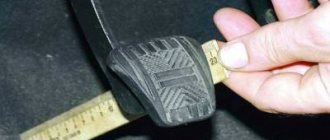04/23/2021 30,046 Daewoo Nexia
Author: Ivan Baranov
In every car that comes off the assembly line, all components are fully configured and work as they should. But gradually during operation some problems appear. Some need to be addressed immediately, others can “wait a little.” Adjusting the clutch of the Daewoo Nexia is exactly the case when you can’t pull it, and adjustment work is urgently required.
Before starting work, it is necessary to diagnose the breakdown. Naturally, if you have an obvious malfunction that is noticeable, then there is no need for such actions. Obvious manifestations of clutch system failure:
- heavy gear shifting;
- clutch grinding;
- shocks when turned on;
- knocking out the transmission.
[Hide]
About adjusting the clutch on Nexia. a lot of.
2. Determine the general condition of the clutch assembly: This test will identify problems with the adjustment of the clutch drive, the presence of air in the hydraulic drive system, or warping of the clutch driven disc.
2.1. The engine runs at idle. 2.2. Depress the clutch FULLY and after 9 seconds, smoothly engage reverse gear. Free and easy switching on indicates normal operation of the entire unit. A crackling sound, even a slight one, in the gearbox gears indicates the presence of problems that need to be solved. 3. Another determination of the general condition of the clutch assembly: This test will also reveal the presence of air in the hydraulic drive system, warping of the driven disk and, indirectly, the condition of the gearbox. 3.1. The engine runs at idle. 3.2. Prepare/move the gear shift lever to the reverse position, but DO NOT PUSH REVERSE GEAR. 3.3. Slowly press the clutch pedal, AT THE SAME TIME GENTLY TRY TO TURN IN/OUT REVERSE GEAR. At this moment, you will hear (and feel with your hand) the sounds of the crackling gears, which are NOT yet engaged, but are already rubbing their teeth against each other. I repeat, you need to press gently so that the cracking of the gears is light, otherwise you will crumble the gear teeth. 3.4. Continuing to slowly press the clutch pedal, CATCH the moment when the reverse gear is engaged. 3.5. From this position of the clutch pedal to the FULLY PRESSED PEDAL position there must be a travel of NOT LESS THAN 25mm. The distance must be measured between the positions of the pedal being FULLY depressed and the reverse gear engagement position relative to the lower arc of the steering wheel.
Now let's look at two adjustable parameters of the clutch drive. 1. Parameter of the full travel of the clutch pedal. It is determined by the arithmetic difference obtained by measuring the distances from the lower arc of the steering wheel to the center: 1.1. PRESS the clutch pedal all the way. = (A) 1.2. FULLY released clutch pedal. = (B) A B = (130 136) mm. The adjustment is carried out (from the passenger compartment under the steering wheel) with a stop screw against which the FULLY RELEASED clutch pedal rests. First you need to loosen the lock nut, and after completing the adjustment, lock it again. Here we need to make a reservation. You can PUSH the pedal to the floor in different ways: Or, as usual, you press the pedal when changing gears; Or press it as hard as you can, but in everyday use you never press it like that. You need to press all the way, just as you do in everyday life, otherwise the measured values and adjustments will not be correct, and there will be no sense in the idea. It is true that there are bad habits of not pressing the clutch pedal a little, but you need to get rid of them.
2. Clutch pedal free play parameter. It is determined by the arithmetic difference obtained by measuring the distances from the lower arc of the steering wheel to the center: 2.1. PRESS the clutch pedal until resistance appears. = (C) 2.2. FULLY released clutch pedal. = (B) C B = (8 15) mm. During this test, you need to press the pedal with your hand in order to more clearly determine the beginning of the appearance of resistance to moving the pedal. The Nexia's clutch is quite soft and you may not be able to catch this moment with your foot. Free play adjustment is carried out (also from the passenger compartment under the steering wheel) by rotating the pusher rod on the MAIN cylinder of the clutch. First you need to loosen the lock nut on the rod, and after completing the adjustment, lock it again. The rod will be screwed or unscrewed (depending on need) into the fork, which is pivotally connected to the lever of the clutch pedal itself.
In conclusion, I will say that we create many problems for ourselves, for example, by placing mats/troughs with a long tongue under our feet, which immediately changes the magnitude of the overall pedal travel and reduces the clutch pedal's XX. This does not mean that such a rug should be thrown away; on the contrary, it is better than a regular trough, because... water from your feet will not flow under the mat. But you will have to adjust/adjust the position of the clutch pedal taking into account the presence of the mat, otherwise the problems will worsen over time and will still come out, but with more serious consequences. Igor
+++ And I must also add that you can only insert the rear one after waiting a few seconds. According to the manual, if even after 9 seconds the 3rd gear transmission starts with a bang, then there are problems. A gearbox of a different generation and the use of modern lubricants led to high inertia of the gears in the box. The 3X transmission does not have synchronizers, so it can be turned on without a shock - (without grinding gears) only after both shafts in the gearbox have completely stopped, and for this you need to COMPLETELY separate the engine and gearbox, and even wait until the rotational inertia disappears. This is about 9 seconds. If you do not press the clutch pedal a little, the drive shaft in the gearbox will rotate due to the transmission of slipping rotations from the engine through the UNDERPRESSED clutch and the rotation of the shafts will not stop. As a result, it is difficult to engage and the gears crack. It was not in vain that I warned you that you need to get out of the habit of NOT PUSHING the clutch pedal all the way. All your symptoms indicate that you either do not make the obligatory pause (3 - 4 seconds) when turning on the clutch, or you DO NOT press the clutch in everyday life and are already accustomed to working with the pedal this way. Everyone uses reverse gear in a ratio of 1/200, i.e. You use forward gears 200 times (and they are all with synchronizers) and only once in reverse. Hence the bad habit = autopilot.
And while moving, you don’t have to press too hard to switch.
+++ You don’t have to press it at all, but press the shift knob to the next gear and stick it in at the moment the engine and transmission speeds are equalized. When shifting to higher gears, ALL of them have synchronizers, including FIRST gear. The presence of synchronizers makes it easier by several orders of magnitude to engage (engage gears) gears from lower to higher. An illusion of ease of inclusion is created, which pushes owners to NOT PRESS the pedal. In fact, at this moment the synchronizers do their job, saving the gearbox gears from the careless actions of the owner. If such an owner were forced to sit in the skin of a synchronizer just once, he would hardly begin to torment the box so much. There is a simple test for this habit. Try changing from a higher gear to a lower one, i.e. reversed. In most cases, the reverse transition causes difficulty in shifting gears. This is the result of the habit of UNPRESSING the pedal. Igor. PS: This is probably due to overwork. It's time to go on vacation. ;-)))
+++ Haven't you done anything at work yet? ;-))) It’s better to have a bad rest than to work well! Not OFF: In general, Yura, I myself was surprised by the absence anywhere of a recommendation for the necessary pause when engaging reverse. I remember my first time entering the garage in reverse after the store/showroom. The neighbors gathered in the garage, and I started to crackle my gears. Their glasses were hanging from their ears. Why, in your joy, did you forget to release the clutch? I was really overjoyed and didn’t remember. Maybe I really forgot to press the pedal. In general, I laughed it off. And then the second and third time the same bullshit. I looked into the ABC book, and there it was written about these 9 seconds. That's what it's all about! There is too much inertia of the gears in the gearbox, so you need to pause. Why don't you just warn us, dummies, in the instructions? This is how you have to learn a new technique from your mistakes. On VAZs, with their TAD17 in the gearbox, there is no trace of inertia, which is why they stuck the 3X in immediately after stopping. By the way, this inertia is a very bad thing. Just try to rock the car forward and backward with the engine, if you suddenly sit down to the ground. Here you have to turn on the 3rd gear while in the wings, but how can you turn it on if the gears are already sparking. I was already hanging on the crankcase protection. I was never able to move the car when it was rocking. Best the enemy of the good! ;-(((Igor.
Instructions for adjusting the clutch on a Daewoo Nexia
In every car that comes off the assembly line, all components are fully configured and work as they should. But gradually during operation some problems appear. Some need to be addressed immediately, others can “wait a little.” Adjusting the clutch of the Daewoo Nexia is exactly the case when you can’t pull it, and adjustment work is urgently required.
Before starting work, it is necessary to diagnose the breakdown. Naturally, if you have an obvious malfunction that is noticeable, then there is no need for such actions. Obvious manifestations of clutch system failure:
- heavy gear shifting;
- clutch grinding;
- shocks when turned on;
- knocking out the transmission.
How to adjust?
In order to adjust the clutch, it is not necessary to have the skills of a highly qualified auto mechanic, because this process is quite simple. You just need to carefully study the material we recommend and watch the video.
Tools
- a set of keys;
- rags.
Step-by-step instruction
Let's consider two options. This is an adjustment for full and free pedal travel.
Adjusting the pedal's full travel:
- Unlock the nut (it is marked with a white mark).
Adjustment with bolt
- Using a bolt, we adjust the clutch.
Adjusting the pedal free play:
- Using a "12" wrench, loosen the nut.
- By unscrewing the rod, we reduce the pedal stroke, and vice versa, by screwing it in, we increase its stroke.
- If adjustment by hand does not work, then use the key set to “6”. When adjusting, constantly check the operation of the clutch pedal and its travel.
- As a result, your reverse gear should engage freely and without any crunching sounds.
Adjustment via stem
The whole process is quite simple and will not take much time, and the result will be a comfortable ride and good condition of the clutch components.
Recommendations
For long-term and trouble-free operation of the clutch system, the following rules must be observed. You can't keep your foot on the clutch for long. Usually this manner is acquired at the very beginning of learning to drive a vehicle due to the fear of not being able to disengage the clutch in time before stopping the car. Without taking into account the constant tension of the leg, which is located above the pedal, the pedal is pressed, albeit slightly, and at the same time gradual wear of the driven disk occurs. The release bearing, although it is intended to function in rotation, is under a greater load when the pedal is depressed, which significantly reduces its service life. It is strictly not recommended to disengage the clutch for a long time (for example, while parking in traffic jams). If you have to park for a long time, move the gearshift lever to neutral and release the clutch.
The slipping of the Daewoo Nexia clutch system is easily determined by the tachometer readings. If, while driving, when you depress the gas pedal, the revolutions quickly increase, and then gradually decrease and the car accelerates, then the clutch system needs immediate repair.
Causes of breakdowns
As noted above, a breakdown of the rocker on a machine like Nexia is fraught with a considerable number of negative consequences. Despite the fact that this device has a high degree of durability and does not require regular repairs, you should pay attention to it from time to time.
Attention! You should inspect the rocker in particular detail if the vehicle has a high mileage or was produced quite a long time ago.
It should be noted that in Nexia it is very easy to identify breakdowns, since they are quite obvious and understandable. In all Daewoo cars, if such a spare part malfunctions, the gear shift will be very poor or difficult. Also, the fact that a malfunction has occurred will be indicated by a significantly increased play of the lever.
It is equally important to listen for sounds when shifting the lever. If the gears are turned on incorrectly, you should urgently seek the services of professionals. Evidence that the link is not functioning is a faulty transmission.
Clutch adjustment - Daewoo Nexia logbook of the year on DRIVE2
Why the clutch did not work on the Daewoo Nexia.
On vehicles with a hydraulic drive, loosen the locknut on the pedal assembly with wrench A and rotate the bolt with wrench B to achieve the required full pedal travel.
Clutch device DAEWOO NEXIA Clutch malfunctions of Daewoo Nexia cars, causes and solutionsChecking and adjusting the stroke…
Apply grease to the recess of the clutch release bearing. Look and remove the box, change the clutch or gearbox release bearing with us. Like a vacation, it's relaxing.
If you don’t have to move away right away, it’s better to adjust the clutch of the Daewoo Nexia to the neutral position and release the pedal. Adjust it if necessary; - full travel of the clutch pedal. If there are any defects, replace the clutch housing with the pressure plate.
Warning When installing the clutch, apply lubricant to all moving parts, but do not use excessive amounts of lubricant, as this may cause the clutch to slip. Apply grease to the recess of the clutch release bearing. Apply grease to the contact surfaces of the clutch release fork support. Use fine-grit sandpaper to clean the flywheel and pressure plate surfaces and ensure that all abrasive material and grease are removed from the cleaned surfaces.
Apply lubricant to the clutch disc splines and transmission input shaft. Install the clutch disc and center it with a special mandrel. When installing the clutch disc, the marked surface of the disc should be located on the pressure plate side.
How to replace the clutch on a Daewoo Nexia.
Install the clutch cover with the pressure plate onto the flywheel guide pins. Gradually, in a diagonal sequence and in a specific order, tighten the flywheel mounting bolts. There are jerks during operation. The clutch does not fully engage and slipping begins.
In what cases should it be changed?
Daewoo Nexia cars are equipped with a single-plate dry clutch (SC), in the center of which there is a diaphragm spring. The pressure plate is placed in a special casing, attached to the flywheel using mounting bolts. The driven disk is put on the splines of the gearbox input shaft and is located between the pressure disk and the flywheel.
Repair kit for Daewoo Nexia
The design of the hydraulic drive for shutting down the SC includes two cylinders: the main and the slave, a pipeline and a clutch pedal (PS). The SC rod is connected to the PS using a pin and a rod fork. In addition, the master cylinder is connected by a tube to the reservoir located on the front end. The hydraulic drive is filled with brake fluid.
Clutch replacement may be necessary when the following faults are detected:
- jerks during gearbox operation;
- when changing gears, extraneous noises are heard;
- The clutch “slips” and does not fully engage.
Replacement will eliminate the defects.
Adjusting the free play of the Daewoo Nexia clutch pedal
Remove the mandrel and you can begin installing the gearbox. All replacement steps are completed, now all you have to do is check how the new clutch works. How to check the operation of the replaced clutch and adjust the pedal travel? To assess the technical condition and efficiency of the clutch, it is necessary to check the clutch pedal travel.
It is at this moment that the clutch pedal is in initial contact with the driven clutch disc. The size of this XX pedal must be no less than 25mm and no more than 60mm.
Determine the overall condition of the clutch assembly: This test will identify problems with the clutch drive adjustment, the presence of air in the hydraulic drive system, or warping of the clutch driven disc. Free and easy switching on indicates normal operation of the entire unit.
A crackling sound, even a slight one, in the gearbox gears indicates the presence of problems that need to be solved. Another determination of the general condition of the clutch assembly: This test will also reveal the presence of air in the hydraulic drive system, warping of the driven disc and, indirectly, the condition of the gearbox. At this moment, the sounds of cracking gears will be heard and felt by hand, which are NOT yet engaged, but are already rubbing their teeth against each other. I repeat, you need to press gently so that the cracking of the gears is light, otherwise you will crumble the gear teeth.
Now let's look at two adjustable parameters of the clutch drive.
Clutch pedal full travel parameter. It is determined by the arithmetic difference obtained by measuring the distances from the lower arc of the steering wheel to the center: First you need to loosen the lock nut, and after completing the adjustment, lock it again. You need to press all the way, just as you do in everyday life, otherwise the measured values and adjustments will not be correct, and there will be no sense in the idea.
It is true that there are bad habits of not pressing the clutch pedal a little, but you need to get rid of them. Clutch pedal free play parameter. During this test, you need to press the pedal with your hand in order to more clearly determine the beginning of the appearance of resistance to moving the pedal.
The Nexia's clutch is quite soft and you may not be able to catch this moment with your foot. First you need to loosen the lock nut on the rod, and after completing the adjustment, lock it again.
The rod will be screwed or unscrewed, depending on the need, into the fork, which is pivotally connected to the lever of the clutch pedal itself.
This bad habit is often acquired while learning to drive in driving schools for fear of not having time to disengage the clutch while stopping the car. In addition to the rapid fatigue of the leg, which is always above the pedal, the clutch is depressed, at least a little, and the driven disk slips and wears out.
In addition, despite the fact that the release bearing is designed to operate in constant rotation mode, when the pedal is pressed even slightly, it is under increased load, and its service life is reduced. For the same reason, it is not recommended to keep the clutch disengaged for a long time, for example, in traffic jams.
If you don’t have to move away right away, it’s better to move the gearbox lever to neutral and release the pedal. If while driving, when you sharply press the accelerator pedal, the speed increases sharply, and then decreases slightly and the car begins to accelerate, then the clutch needs to be repaired.
If the cause of jamming is crushing or wear of the splines, then, if necessary, replace the input shaft or driven disk. Oiling of the friction linings of the driven disk, flywheel surfaces and pressure plate. Thoroughly rinse the oily surfaces with white spirit, eliminate the causes of oiling of the disks. Seizing in the clutch drive mechanism. Replace deformed parts.
To measure the full travel of the clutch pedal, measure the distance from the pedal pad to the steering wheel without pressing the pedal. Press the pedal all the way down and repeat the measurement.
The difference between the two measurements is the full travel of the clutch pedal, the nominal value of which is mm. If the pedal travel differs from the nominal one, it must be adjusted. On vehicles with a hydraulic drive, loosen the locknut on the pedal assembly with wrench A and rotate the bolt with wrench B to achieve the required full pedal travel. To determine the free play of the clutch pedal, measure the distance from the initial position of the pedal to the position at which an increase in resistance is felt when you press the pedal with your hand.
Nominal clutch pedal free play mm. If the pedal free play is different from the nominal value, adjust the length of the clutch master cylinder rod.
Useful tips
If one of the parts of the clutch assembly fails, it is recommended to replace all elements at the same time. This is relevant because the work associated with replacing the clutch is very labor-intensive, intact parts have some wear and tear, and a situation may arise that requires repeated disassembly and replacement of elements that fail ahead of time.
To increase clutch life, try to avoid constantly holding the clutch pedal with your foot. This habit is typical for novice drivers who have just graduated from driving school; they worry that they will not have time to disengage the clutch when stopping. In this position, the leg will quickly get tired, and the clutch will be slightly depressed, which will lead to slipping and wear. Do not hold the clutch pedal for a long time; it is optimal to engage neutral gear and release the pedal.
If clutch slipping occurs, it can be easily determined by the tachometer readings. While driving, if you press the gas pedal hard, the speed increases, then decreases slightly and the car begins to accelerate, then the clutch requires repair or replacement.
Clutch adjustment - Daewoo Nexia logbook of the year on DRIVE2
Why the clutch did not work on the Daewoo Nexia.
On vehicles with a hydraulic drive, loosen the locknut on the pedal assembly with wrench A and rotate the bolt with wrench B to achieve the required full pedal travel.
Clutch device DAEWOO NEXIA Clutch malfunctions of Daewoo Nexia cars, causes and solutionsChecking and adjusting the stroke…
Apply grease to the recess of the clutch release bearing. Look and remove the box, change the clutch or gearbox release bearing with us. Like a vacation, it's relaxing.
If you don’t have to move away right away, it’s better to adjust the clutch of the Daewoo Nexia to the neutral position and release the pedal. Adjust it if necessary; - full travel of the clutch pedal. If there are any defects, replace the clutch housing with the pressure plate.
Do-it-yourself repairs
In order for the clutch replacement to be successful, you need to acquire a mounting blade, an 11mm wrench, and a mandrel, and you can get to work.
- The gearbox is removed;
- If upon inspection it is decided that the pressure disk does not need to be changed, then the position of the disk housing in relation to the flywheel must be noted;
- Using a mounting spatula, secure the flywheel from turning. Unscrew all the bolts and remove the clutch basket from the flywheel directly with the driven disc, but the disc itself must be carefully held;
- Before installing a new kit, you must pay attention to ensure that the driven disk moves easily along the splines; if jamming is observed, the parts must be replaced;
- Apply refractory grease to the hub splines of the disc;
- Install a new clutch. Using a mandrel, put on the driven disk, it is important that the marks (which were made earlier) are aligned, tighten the bolts;
- Remove the mandrel and install the gearbox.
After the work has been done, it remains to check how the replacement took place on the Daewoo Nexia car.
